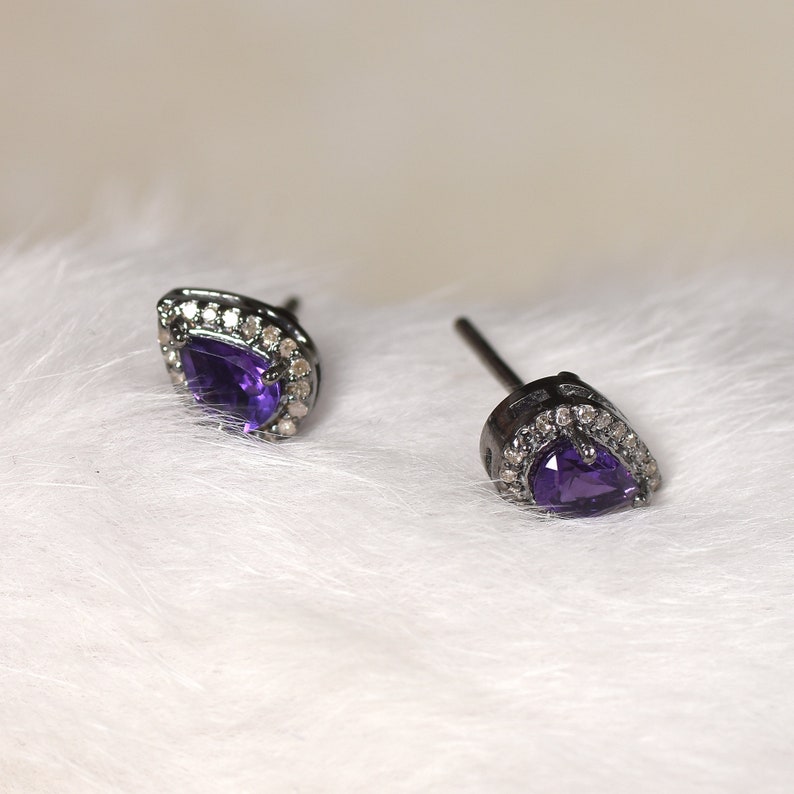
AMETHYST - FEBRUARY BIRTHSTONE
Share
Amethyst, is the name derived from the Greek word, Amethystos meaning, not intoxicated. It is associated with February the month the Romans dedicated to Neptune, their water-god, and with no surprise it’s known as traditional birthstone of that month. Amethyst is the zodiac stone for those born under the sign of Pisces as winter makes way for spring, and is considered as a Gem of Spring, from February 19 to March 20.
In today’s classification it is a semi-precious stone but to the ancients it has been esteemed as gemstone, it was a Gem of Fire, a precious stone worth then, as much as diamond. The use of Amethyst can be traced as far back as 25,000 B.C. to the Neolithic people in Europe. Its spiritual and legendary energies made it popular for beads and amulets in many cultures, as a stone of royalty, utilized in crowns and jewelry. Ancient Egyptians used it as a healing stone to ease fears and guilt, and as a strong protector while traveling.
Amethyst is known as nature’s tranquilizer, it calms and soothes, assisting the transmission of neural signals through the brain. Amethyst carries a high, sweet energy, particularly stimulating to the Third Eye, Crown, and Etheric Chakras.
Amethyst stone is made up of silicon dioxide. The presence of manganese in clear quartz produces Amethyst, while additional amounts of iron and aluminum deposits, as well as natural irradiation, vary the purple coloration. It ranges in hue from pale red-violet to deep violet; lavender to violet; and may be transparent or opaque. Amethyst crystal is one of several varieties of quartz, with a hardness of 7 on the Mohs scale, so it is a durable stone. The color of some amethyst can be subject to fading by prolonged exposure to direct sunlight or bright display lights.
In addition, it is sometimes layered with white quartz as Chevron Amethyst; blend of Amethyst, clear and smokey quartz together as Brandberg Amethyst; found in combination with Cacoxenite; mixed with Citrine as Ametrine; or in rare cases, rutilated with Goethite. Natural or intentional heating can also change the color of amethyst to a pale green called as prasiolite or as green amethyst.
This crystalline quartz is found in many locations around the world. Enormous deposits of amethyst in South America and Africa provide enough material to keep amethyst’s price low enough that most people can easily afford it. Small amounts of amethyst are found at many locations throughout the world in igneous, metamorphic, and sedimentary rocks. Other productive amethyst deposits are located in Canada, France, India, Madagascar, Mexico, Morocco, Myanmar, Namibia, Russia, South Africa, Sri Lanka, Tanzania, and the United States.
The combination of attractive colors, good durability and affordability, makes amethyst a favorite gem of artisans, jewelers, craftspeople and
In today’s classification it is a semi-precious stone but to the ancients it has been esteemed as gemstone, it was a Gem of Fire, a precious stone worth then, as much as diamond. The use of Amethyst can be traced as far back as 25,000 B.C. to the Neolithic people in Europe. Its spiritual and legendary energies made it popular for beads and amulets in many cultures, as a stone of royalty, utilized in crowns and jewelry. Ancient Egyptians used it as a healing stone to ease fears and guilt, and as a strong protector while traveling.
Amethyst is known as nature’s tranquilizer, it calms and soothes, assisting the transmission of neural signals through the brain. Amethyst carries a high, sweet energy, particularly stimulating to the Third Eye, Crown, and Etheric Chakras.
Amethyst stone is made up of silicon dioxide. The presence of manganese in clear quartz produces Amethyst, while additional amounts of iron and aluminum deposits, as well as natural irradiation, vary the purple coloration. It ranges in hue from pale red-violet to deep violet; lavender to violet; and may be transparent or opaque. Amethyst crystal is one of several varieties of quartz, with a hardness of 7 on the Mohs scale, so it is a durable stone. The color of some amethyst can be subject to fading by prolonged exposure to direct sunlight or bright display lights.
In addition, it is sometimes layered with white quartz as Chevron Amethyst; blend of Amethyst, clear and smokey quartz together as Brandberg Amethyst; found in combination with Cacoxenite; mixed with Citrine as Ametrine; or in rare cases, rutilated with Goethite. Natural or intentional heating can also change the color of amethyst to a pale green called as prasiolite or as green amethyst.
This crystalline quartz is found in many locations around the world. Enormous deposits of amethyst in South America and Africa provide enough material to keep amethyst’s price low enough that most people can easily afford it. Small amounts of amethyst are found at many locations throughout the world in igneous, metamorphic, and sedimentary rocks. Other productive amethyst deposits are located in Canada, France, India, Madagascar, Mexico, Morocco, Myanmar, Namibia, Russia, South Africa, Sri Lanka, Tanzania, and the United States.
The combination of attractive colors, good durability and affordability, makes amethyst a favorite gem of artisans, jewelers, craftspeople and

1 comment
Awesome!!!